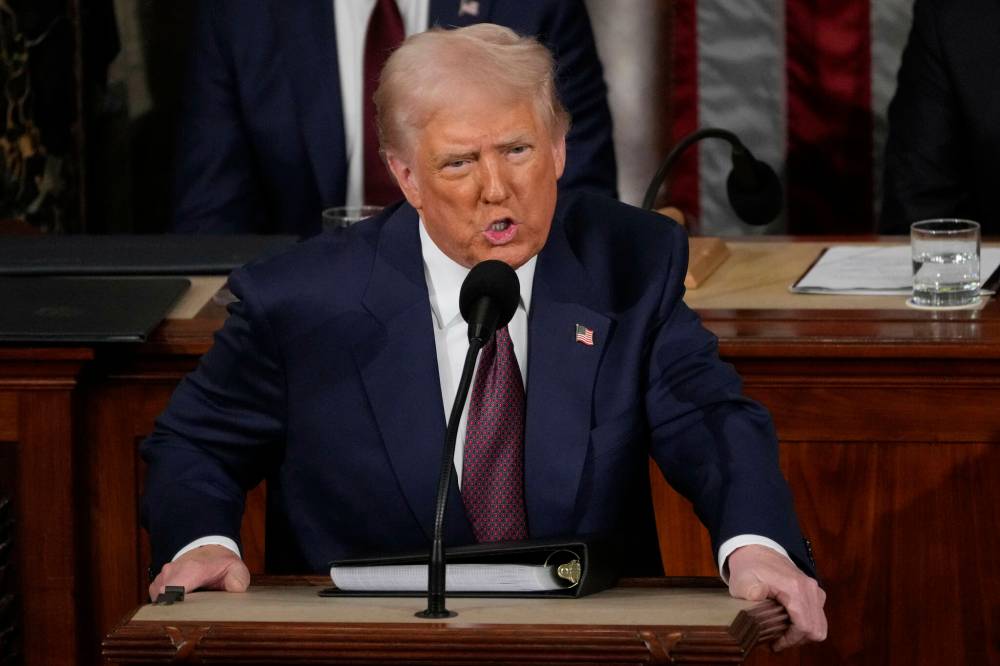Even if tariffs go away, Canada should look elsewhere
Advertisement
Read this article for free:
or
Already have an account? Log in here »
To continue reading, please subscribe:
Monthly Digital Subscription
$1 per week for 24 weeks*
- Enjoy unlimited reading on winnipegfreepress.com
- Read the E-Edition, our digital replica newspaper
- Access News Break, our award-winning app
- Play interactive puzzles
*Billed as $4.00 plus GST every four weeks. After 24 weeks, price increases to the regular rate of $19.00 plus GST every four weeks. Offer available to new and qualified returning subscribers only. Cancel any time.
Monthly Digital Subscription
$4.75/week*
- Enjoy unlimited reading on winnipegfreepress.com
- Read the E-Edition, our digital replica newspaper
- Access News Break, our award-winning app
- Play interactive puzzles
*Billed as $19 plus GST every four weeks. Cancel any time.
To continue reading, please subscribe:
Add Free Press access to your Brandon Sun subscription for only an additional
$1 for the first 4 weeks*
*Your next subscription payment will increase by $1.00 and you will be charged $16.99 plus GST for four weeks. After four weeks, your payment will increase to $23.99 plus GST every four weeks.
Read unlimited articles for free today:
or
Already have an account? Log in here »
Hey there, time traveller!
This article was published 06/03/2025 (224 days ago), so information in it may no longer be current.
By the time you read this, U.S. President Donald Trump’s on-again-off-again 25 per cent tariff on all Canadian exports to the U.S. may be off again. Or it may still be on again.
Or it may be off again with a 90 per cent chance of being on again in 30 days, while another round of U.S. tariffs on steel and aluminum imports are only days away and a nebulous round of global U.S. retaliatory tariffs hangs over next month like April showers, but sans anything like flowers.
Does it even matter?

Julia Demaree Nikhinson / the associated press
U.S. President Donald Trump
Well, yes — in the short term, it certainly does. The impacts on Canada are huge, from job losses to corporate income to the amount of money that our governments can collect in tax revenues. It’s fair to say that tariffs from our largest trading partner are the single largest economic issue that Canada has faced since COVID, and any breathing room we can get to trade in the U.S. in a quasi-normal fashion would be welcome.
But that doesn’t mean we should relax. In fact, if the tariffs are withdrawn, we should act as though they are still in place. In the long term, whatever way U.S. tariffs go, we should continue to move with all possible speed to sell Canadian products somewhere else. We should still buy Canadian to every extent possible, and we should look at ways to use and sell Canadian energy resources in ways that don’t involve our neighbour to the south.
Because Donald Trump’s tariff bait-and-switch blackmail act is just going to continue, with the next act likely being Trumpian demands on a renegotiated Canada-U.S.-Mexico trade deal, and everything seems to be able to change based on how President Trump feels after lunch.
Is there even an agreement on trade right now? The USMCA trade deal — signed by Trump himself — is supposed to limit tariff action and sets a reasonable standard, with specific exceptions, of free trade between Canada, the U.S. and Mexico. But the U.S. president has put the “trump” in trumped-up excuses for action against Canada, using his sudden concern about fentanyl deaths in the U.S. to give him a lever to step around the agreement and introduce tariffs.
Taking off the latest round of tariffs, quite simply, won’t undo what’s been done.
Donald Trump’s America will have to earn back our trust.
But more than that: when companies make plans — and invest resources — to sell products elsewhere than the United States, it will be difficult, and expensive, to lure them back. Canada, for example, is the largest importer of refined zinc to the U.S., where much of the metal is used for making galvanized steel, though about a quarter of is also used in zinc compounds needed mainly by the rubber, chemical, paint and agricultural industries. The U.S. Geological Survey ranks zinc as a critical mineral, precisely because the U.S. needs to import so much of the metal.
One-third of the U.S. zinc imports come from Canadian mining company Teck, which announced Tuesday it has spent months making plans, landing warehousing space and port facilities to sell its zinc in Asia instead of to the United States. The move will not only give Teck an option to broaden its sales basis, it will remove potential tariff revenues from the U.S. and it will make it much harder — and more expensive — for American manufacturers to source the zinc they need.
Once that sales model is entrenched and markets are established, it will be difficult to lure Teck back to U.S. customers — particularly to a market that is, right now, fractious, fickle, undependable and precarious.
Once bitten, twice shy.
Have only one unstable market? Diversify.

